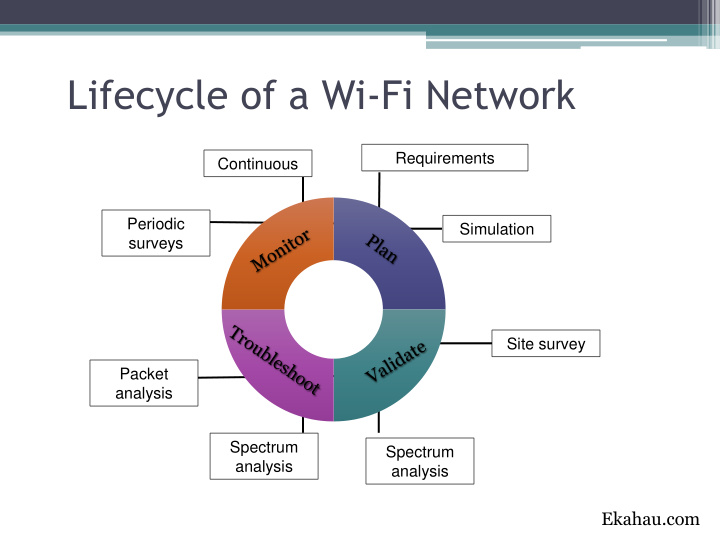



Lifecycle of a Wi-Fi Network Requirements Continuous Periodic Simulation surveys Site survey Packet analysis Spectrum Spectrum analysis analysis Ekahau.com
Types of Surveys • Active Survey measure packets in two directions (send & receive). Used for packet loss, packet delay,… • Passive Survey listen to probes & beacons passively. Used for coverage & SNR maps, etc. • Hybrid Survey passive & active simultaneously
Ekahau Site Survey 1. Import map 2. Set scale, using a long wall 3. Choose your survey method - continuous or stop & go 4. Review data and create reports
Ekahau WiFi Planner • Set your site requirements and capacity requirements. • Create a template if you have a standard that will be used for multiple sites. Read: Wi-Fi Capacity Analysis for 802.11ac and 802.11n: Theory & Practice
Maps • Import a quality map – jpeg will work and is typically fine when surveying, but CAD will save you time in the planning stage. • If you don’t have a CAD file, you will need to build walls and set scale.
Ekahau Tool Checkout! • Send us an email to schedule a checkout • Feel free to just request the tool to do surveys & planning on your own or request Lane ESD to do the surveys/planning and generate reports.
802.11ac
802.11ac: An Overview 20 5G 80/160 MHz 40 5 GHz Only Increased Speed 80 2.4G channels 160 o Focuses on capacity-rich, o Breaks “gigabit” o Very wide channels low-interference spectrum barrier o One of the primary o Benefits entire Wi-Fi o Max of 6.9 Gbps reasons ecosystem for 11ac’s very high data rates Up to 8 Multi-user MIMO A 256-QAM (MU-MIMO) spatial streams P o More efficient o Simultaneous downlink Tx o N-fold efficiency modulation to single-stream clients improvement o 33% data rate gains o Multiplies network capacity o Requires client-side o Very short ranges only support o Key differentiator from 802.11n o Wave 2 only o Requires 11ac clients Ruckus.com 8
802.11n > 802.11ac W1 > 802.11ac W2 cisco.com
Ruckus Debuts First 802.11ac Wave 2 AP • First AP to be able to service up to three concurrent streams to different users in what was a one-user-at-a-time paradigm for client access in 11ac Wave 1 and the earlier 11n standard. • Supports dual 1 Gbps uplinks • Ruckus claims that the R710 can go to 1,733 Mbps in 5 GHz (with 80 MHz channels and 256 QAM), and 800 Mbps in the 2.4 GHz spectrum http://www.networkcomputing.com/wireless-infrastructure/ruckus-debuts-first-80211ac-wave-2-ap/a/d-id/1319738
Implementing 802.11ac • Use Ekahau Planner! • Ensure minimum of 1 Gbps uplink ports available per AP. • Consider two 1 Gbps uplink ports, some APs have two ports that support link aggregation for more bandwidth and redundancy • Buy switches that support 802.3at (PoE+), some new ac APs may have limited functionality without it. • Is your edge switch and the core 10Gbps?
Recommend
More recommend